The Artfully Pink House of Liberty and Justice
Sarah Rohr
Special Contributor
Photos by Sarah Rohr
Mouse over photos for captions
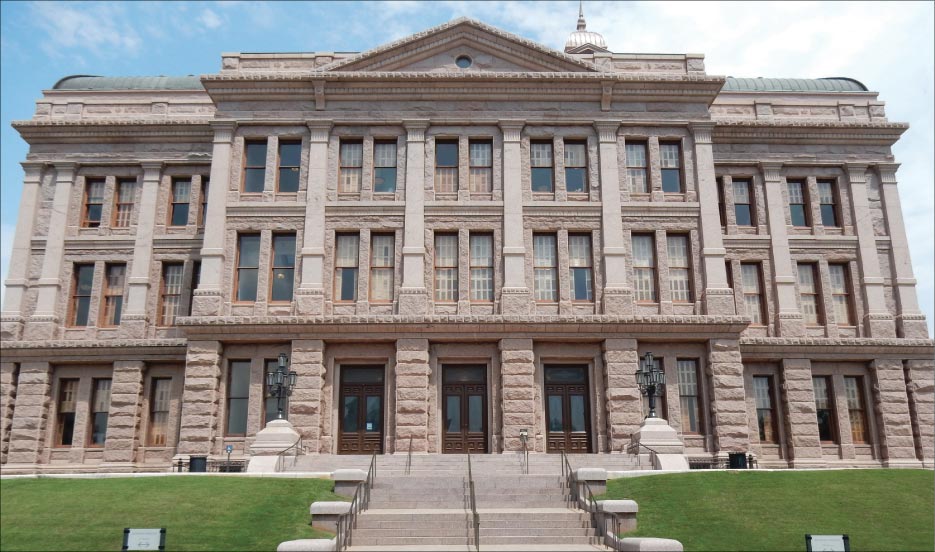
Traveling in and around Austin, Texas, it’s hard not to see limestone, as it is the prevalent stone building material utilized structurally and decoratively on houses, schools, businesses and official state buildings, as well as places of worship.
It is curious, then, that when gazing upon the Texas State Capital one sees the warm, pink hues of a summer sunset, not the stark, cool white of a full moon dusted with clouds that is commonly associated with limestone.
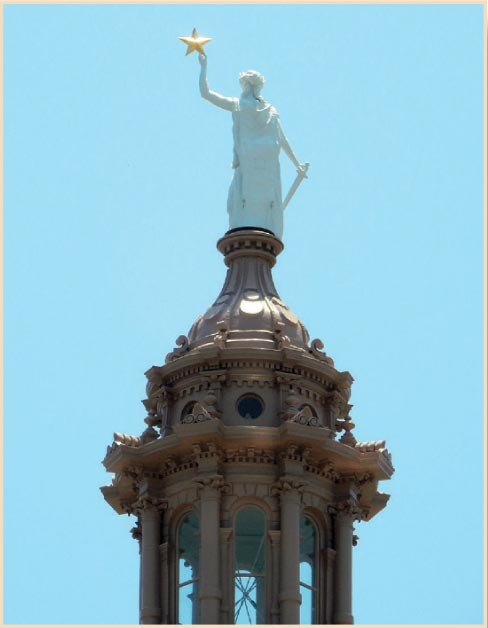 Perhaps due to limestone’s ubiquitous presence in the area, it was originally the aptly chosen stone for the fourth and current incarnation of the Texas State Capital, in part for its easy acquisition as well as for its buttery texture and ease of cutting.
Perhaps due to limestone’s ubiquitous presence in the area, it was originally the aptly chosen stone for the fourth and current incarnation of the Texas State Capital, in part for its easy acquisition as well as for its buttery texture and ease of cutting.
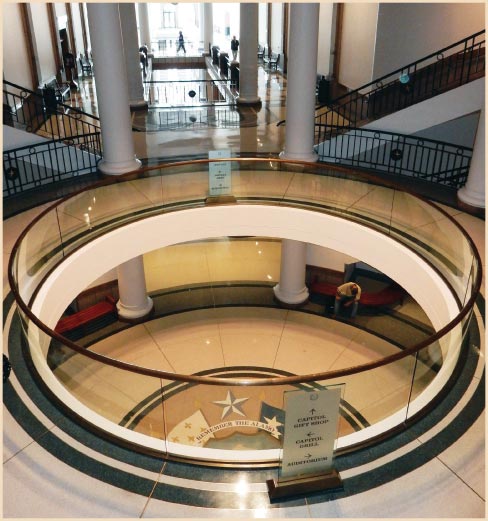 This material choice was also informed by the fact that the original plan for the capital was intended to be a highly ornate stone structure with no shortage of sculptural frills. In the original plans a rarified elegance was written into the design.
This material choice was also informed by the fact that the original plan for the capital was intended to be a highly ornate stone structure with no shortage of sculptural frills. In the original plans a rarified elegance was written into the design.
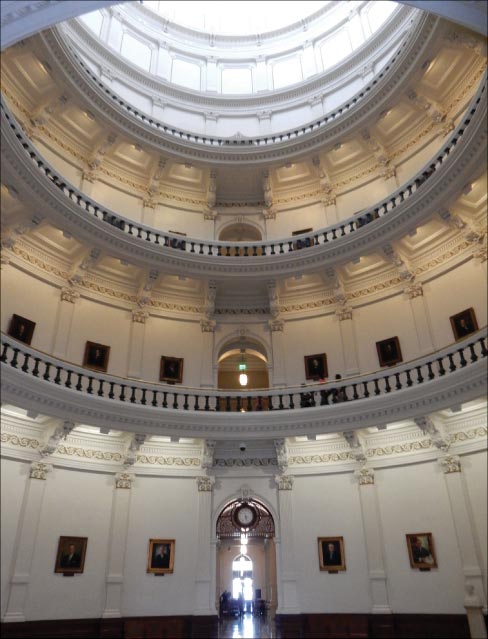 Alas, a discovery during the building process led to a realization that altered the fate of the capital building: black streaking in the chosen limestone was occurring through oxidation. As the iron stored within the limestone was exposed, a kind of black tarnish appeared on the surface, reminiscent of black mold.
Alas, a discovery during the building process led to a realization that altered the fate of the capital building: black streaking in the chosen limestone was occurring through oxidation. As the iron stored within the limestone was exposed, a kind of black tarnish appeared on the surface, reminiscent of black mold.
Luckily this timely discovery occurred during the construction of the basement, therefore there was leeway to alter the course of the rest of the building. After a lengthy discussion lasting over two years it was decided, to the chagrin of some, that the remaining portion of the capital would be constructed with “Sunset Red” granite.
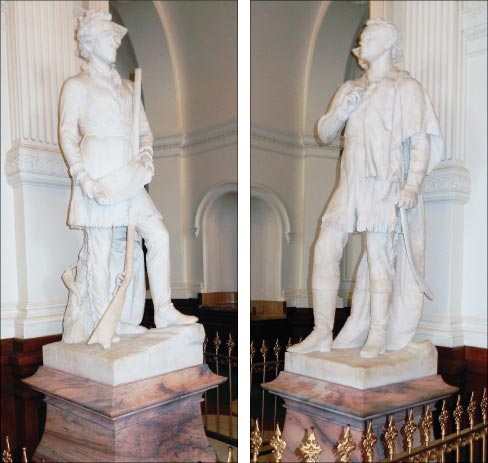 The rugged and simple beauty of the current capital is a direct result of a change in materials, and the stone was limestone course-corrected with granite. According to Chris Currens of the Texas State Board of Preservation, the discovery, “simplified the detail, I can’t say to a stone that it’s exactly the same design. Rather instead of having a freeze carved into the tympanum, what you see now is simple stone… you have the tablature that has been carved out, it’s been left plain, but they didn’t say, ‘we’re going to ease that arch a little.’
The rugged and simple beauty of the current capital is a direct result of a change in materials, and the stone was limestone course-corrected with granite. According to Chris Currens of the Texas State Board of Preservation, the discovery, “simplified the detail, I can’t say to a stone that it’s exactly the same design. Rather instead of having a freeze carved into the tympanum, what you see now is simple stone… you have the tablature that has been carved out, it’s been left plain, but they didn’t say, ‘we’re going to ease that arch a little.’
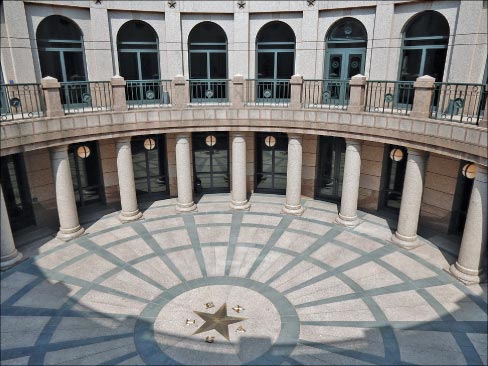 “The changes in design material are reflected in choices– such as in lieu of an urn at the top of every pilaster as you go around the building, you instead have the urns expressed four or five different times at the top of the pilaster.
“The changes in design material are reflected in choices– such as in lieu of an urn at the top of every pilaster as you go around the building, you instead have the urns expressed four or five different times at the top of the pilaster.
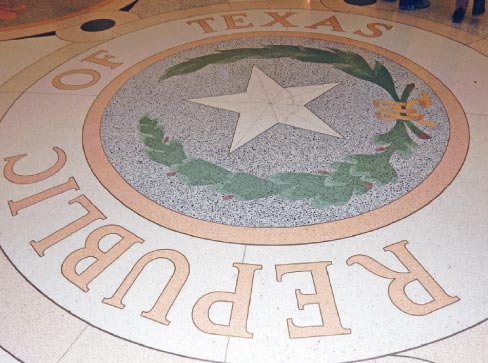 “If you look at the original drawings, they were working with butter versus ice (a softer versus a more brittle stone). The contractors and masons had far more options with the limestone, and granite is so much more difficult to work. They didn’t change the design, they just simplified the level of detail. That’s the short and sweet of it.”
“If you look at the original drawings, they were working with butter versus ice (a softer versus a more brittle stone). The contractors and masons had far more options with the limestone, and granite is so much more difficult to work. They didn’t change the design, they just simplified the level of detail. That’s the short and sweet of it.”
An Interesting Proposition
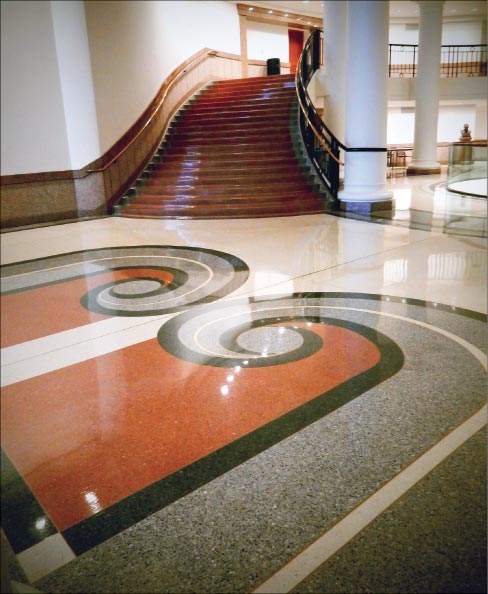 The history of the Texas State Capital construction has an interesting footnote that occurred twice in noteworthy ways, namely bartering.
The history of the Texas State Capital construction has an interesting footnote that occurred twice in noteworthy ways, namely bartering.
The first barter occurred after the capital building commission put out the advertisement to contractors: they offered to trade three million acres of publicly designated land in exchange for the building of The Texas State Capital. The total cost of the capital came to over $3.7 million dollars. For a time, the 3 million allotted acres became the world’s largest ranch, called XIT. While XIT ranch has long since disbanded, a museum stands to educate the public on the life and times of cattle ranchers, cowboys and the huge herds of cattle and the wide-open spaces where they grazed.
Barter “Part Deux”
Texas history records state that the second barter-for-building occurred when the lead contractor on the capital building project — a man by the name of Abner Taylor — recommended that the remainder of the building be constructed from a limestone quarried near Bedford, Indiana. But Texas pride won out. The Capital Board and Governor John Ireland rather fancied stone that originated from within the state of Texas, so it was “Sunset Red” granite that became the sought-after stone.
The “Sunset Red” granite that now stands tall in downtown Austin was mined from Granite Mountain, near current day Marble Falls. The stone made the grade, and Nimrod L. Norton and his partners W. H. Westfall and G. W. Lacy offered it at no cost.
Nimrod L. Norton was one of the three-member strong Capital Building Commission who selected the architect and watched over the creation of the building, and it was at his prompting that the donation was made. In order for the stone to be transported from the quarry to the capital, the second noteworthy barter occurred and the Texas government paid for the construction of a narrow gauge railroad to transport the stone from Granite Mountain to Burnet, Texas (approximately 54 miles from Austin). And that is the brief version of a long and winding tale of how the Texas State Capital comes in the shade of sunset.
A Trip Through the Building
Approximately one million visitors per year will cross the terrazzo floors of this Italian Renaissance Revival structure, and will tour the chambers in the building still in active use, as well as those that are retired from use.
The rooms that are open solely for their historical context and significance, such as the former home of the Supreme Court and the former State Treasurers Office are now occupied by the curious school children, tourists, locals and history buffs alike.
These beautifully preserved chambers provide entrée and insight into the tremendous investment in quality craftsmanship. This attitude is evident in the desks that State Representatives still use today, as well as the desks of current-day senators that date back to over a century ago, and have now been retrofitted for all the outlets and power cords necessary to support technology of modern politics.
The visitors entrance of the capital has its own version of “royal guards” in the form of Texas Public Safety Officers who wear cowboy hats as part of their uniform. As one passes through the requisite security line you enter into a veritable art gallery that includes a painting of the famed Davy Crockett in full buckskin regalia, who seems to gaze upon the battle scene across from where the “the king of the wild frontier” hangs.
As you walk past the former State Treasurer’s office you come upon two life-like stone statues carved by renowned sculptor Elisabet Ney. This second set of greeters that visitors encounter are two creamy beige, realistic marble sculptures of Sam Houston and Stephen F. Austin, who contributed their surnames to two big cities in Texas, as well as being important fixtures in the early formation and statehood of Texas.
Visitors and officials then enter into a rotunda that blossoms upward toward a very ornate ceiling with Texas spelled out in a circular design wrought in a brassy gold.
The rotunda is also called the “whispering room,” as the Texas Capital docent explained, due to the quality of sound in the great, circular room, and how sound can travel so that softly spoken words can be distinctly heard in distant regions around the room.
The four stories of the rotunda play host to very true-to-life portraits of past governors. After the completion of a governor’s term in office, a new painting is installed, and all of the previous governor paintings are rotated in a spiral from the first to the fourth floor; the whole change-up takes approximately 2 days.
Looking down into the rotunda, the terrazzo floors tell the story of Texas’s dependence, independence and interdependence through inlaid flags that depict which authorities lorded over the state. Included as well is the flag that for a decade proclaimed Texas to be a sovereign nation, and the present-day emblem of statehood and Texan unity.
A word of advice: If you’re taking the visitor’s tour, schedule a time when the legislative body is not in session — which is 19 months out of every 2–year cycle; they are on duty 5 months out of that 2–year cycle.
With a lot on the lawmaker’s plates, it’s no wonder that The Texas Preservation Board has their work cut out and executed primarily during those 19-month breathers. That’s when all the major repairs are scheduled, with the aim and goal of being completed before they enter back into session.
In an interview with Chris Currens and Bob Cash – seasoned employees of the Texas Preservation Board, Mr. Cash noted that it is not the stone that demands the bulk of time and attention — rather it is everything that is attached to the stone that requires finesse and care, in order to stay functional and to maintain the standards of integrity and beauty as laid out by the designers.
The Capital Gets an Extension
The Capital Extension was a project taken on by the Texas Preservation board after a 1983 fire wreaked havoc on the building, resulting in major structural damage, which led to some significant restoration projects over the course of the next decade.
After a pragmatic review of the functionality of the building it was clear that overcrowding was occurring. In 1993, the re-opened capital had doubled in size and yet the historic North view was in no way harmed. That’s because the capital extension was built almost entirely underground.
This below ground construction is a hive of activity) where all the representatives, senators and staff services reside. You can view the throwbacks in design through the intricate terrazzo flooring, Sunset Red granite design features and accents.
When the capital extension was being designed, the team “was conscious of not mimicking the original design and creating an imitation of the capital, rather they aimed to create a space that was dignified and that related very much to the original building, but wasn’t a theme park knock-off,” said Chris Currens.
“Furthermore,” said Currens, “The terrazzo flooring in the underground extension was inspired by The Paige Brothers’ 1936 installation inside the original capital building that was installed to celebrate the centennial.” However, the underground wing is surprisingly inconspicuous from the street level. The minimalist give-away is a large rectangular panel of windows, surrounded by shrubbery, which functions as a skylight to let in the abundant Texas sunlight.
Wait — isn’t Austin solid rock when you dig a little deeper?
Yes, in fact the spot chosen required a 65-foot dig into the limestone beneath the light covering of soil.
In honor of the original capital building, a bald rotunda was constructed — an outdoor version of the rotunda sans its crowning top. The bald rotunda is open-aired and the gold-hued “Texas” inscribed in the center of the circular construction mirrors the interior capital’s skyward version — and the outdoor version also doubles as a drain.
A Great View of the Goddess of Liberty
A riveting design feature in the extension is that from the descending balcony that surrounds the rectangular row of windows where there is a spectacular view of the exterior dome of the capital building, with the crowning statue at the apex of the original building.
The current statue is an aluminum replacement some 1,000 pounds lighter and of less electrically conductive material than her Zinc predecessor — reasons that were the impetus for the State Preservation Board to have another goddess constructed. The original goddess of Liberty now stands proudly in one of the State Preservation Board’s other “wonders:” The Bob Bullock State History Museum.
Good People Doing Honest Work
After paying the Board a visit to inquire about all things related to the capital, it was astonishing to note the scope of projects they oversee, from the capital building and extensive grounds, The Bob Bullock State History Museum, to the Governor’s mansion and many more sites and projects, with an emphasis on care and tending the extensive stone work.
The folks interviewed exhibited a deep investment and sense of importance in their work. If you visit any of the sites they preserve, you may notice how impeccable the quality of workmanship truly is; you can see it in the wax polished floors, and the beautiful stone free of grime or residue, every surface tended with an observant eye and by hands that do not mind the dirty work.
The Texas Capital is a living monument to the esthetic values and skilled workmanship of Texas’s stone masons and carvers; by its very nature it is a space that conveys the attributes of excellence and duty.
If you are drawn to Austin as a lover of stone or for its vibrant music scene and agreeable weather in the fall and winter months, pay the Texas State Capital a visit, as it is one of Texas’s many wonders. For more information visit http://www.tspb.state.tx.us/.
Special thanks to Chris Currens and Bob Cash for taking time out of your busy schedules to meet and discuss the history and caretaking of the capital building.